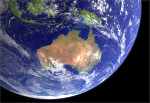|
|
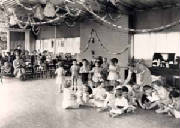
|
| 1949 - Christmas Party at my kindergarten |
KINDERGARTEN
In 1944, I attended the Robert Cochrane Free
Kindergarten, in Minona St, East Hawthorn, not far from our place in Auburn. It is still there!
The Kinder opened in 1911, and in 2011 celebrated
its 100th anniversary.
In the grounds of the Kinder there was an old
cable tram, in which we played. The Kinder had many tall pine trees, which survive until the present day. The most important
"subject" I learned was "painting" and I did many beautiful works of art!
MILK
In 1950, the Government had started
tio recognize the importance of diet and nutrition for its citizens of the future. It had introduced the distribution of free
milk to Australian schools, for kids under the age of 13. The pasteurized milk was delivered to the schools each morning
in glass half-pint bottles, one for each child. Teachers were expected to ensure that each kid drank their milk - straws
were provided.
Many families, particularly those from the inner suburbs, were almost on the poverty line, and could
not afford purchasing fresh milk for their kids.
Free milk continued to be made available across the school system for many years.
POLIO VACCINATIONS
Free
SALK vaccinations were made availabe to all children as part of the Government's mass immunisation program in the late 1940s.
We got our shots at the local town hall.
WAR
SAVINGS BONDS
With the outbreak of WWII it was again necessary for the goverment to find ways
to raise money for the war. A new 6d War Savings Stamp was designed together with a new booklet format was printed. When 32
6d War Savings stamps had been affixed to this card it would be accepted for a War Savings Certificate of £1 face value at
any savings Bank or Money Order Post Office.
I owned one of
these booklets around 1943 and recall visiiting the Post Office with my mother to spend 6d on a war savigs stamp. In
those days, 6d was a lot of money.
FOOD AND CLOTHING RATIONING
Shortages
of foodstuffs, clothing and other products were part of life on the homefront during World War II. The first controls over
the production and distribution of products were introduced in 1940, partly due to disruption of shipping. In 1942, after
Japan entered the War, comprehensive rationing was introduced to manage shortages and control civilian consumption. The first
product to be rationed was clothing, gazetted on 12 June 1942. Each adult was allowed 112 clothing coupons per year. Tea rationing
was introduced the following month, followed by sugar, butter and then meat. After the War, rationing was gradually phased
out. Clothing rationing was abolished on 24 June 1948. The last rationed product was tea, which ended in July 1950.
I can remember going in to the grocer's shop which was next door to our shop in Auburn around
1944 to buy some butter, and handing over the required card. The grocer would remove the coupon(s) .
The day before petrol rationing was intrododuced, motorists in Melbourne (and no doubt
other places) indulged in an orgy of petrol-buying, carrying away full tanks and drums, cans and even bottles. A lot of petrol
was spilled in the buying frenzy.
I suppose the most evident inconvenience of the war for those at home was rationing -
mainly of petrol, food and clothing but also things like tobacco and newsprint. This led to displays of greed and selfishness
by some in the community. It also produced two other wartime phenomena - hoarding and the black market. One man was found
to have hoarded 200 44gal drums of petrol.
When it was announced that rationing of clothing was to be introduced, shoppers
in some places rushed the stores and carried away armloads of clothing in what was described as a ‘frenzied, unedifying
stampede’. I remember the shopkeepers cutting the coupons out of the ration books with a pair of scissors as purchases
were made. In the bigger stores, they would put the money and the docket in a cylindrical container, attach it to a pulley
on an overhead wire, pull the cord, and send it flying up to the cashier’s office, high above the floor. The cashier
would send the change back in the same way.
Tea, sugar, meat and butter were rationed. In 1942, each person over nine
years of age was entitled to one ounce of tea per week (I think it was increased to two ounces later), and you had to register
with a shop to get your ration. Some people soon tumbled to the fact that they could register with several shops, but I think
something was done to stop that from happening.
Because of the petrol shortage, many cars were simply put up on blocks.
SHOPPING
Shopping in the 1940s
was very different to now! There were no supermarkets, and most things were bought over the counter. In Auburn, we were surrounded
by all sorts of small shops! The floor of the butcher shop was covered in sawdust and Mum would buy exotic meat products
such as sheep's tripe, sheeps' brains, pigs' heads and cook these up, often in the newly invented pressure-cooker.
Grocer shops generally had long wooden counters which were scrubbed daily by the proprietor.
There
were also "shops" which came to you! These included horses and carts such as the baker, the iceman, the draper, the bottle-oh,
the milk cart. and a cart which sold pots and pans. Clip-clop!!!
The bottle-oh bought beer bottles from kids - we got a a halfpenny for each bottle!
Every so often we would be taken into town on the train and visit the big department stores such as Myers, Foys, Ball
and Welch, the Leviathan, and sometimes to the Victoria Market and the Eastern Market.
The many Arcades and Lanes were a source of entertainment and discovery! There was Royal Arcade (with Gog and Magog
striking the hours on a huge clock - still there!).
MIlk bars were in their infancy - soft drinks included the Marchants brand, with the hard rubberised screw top bottles.
No cans then! Bottles had redeemable deposits of 3d.
MIlk shakes, malted milks, and spiders were sold in tin
containers. A shake cost 9d.
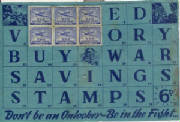
|
| 1944 - War Savings Certificate and Stamps |

|
| 2011 - Gog and Magog, Royal Arcade |

|
| 1949 - the Botftle-Oh! |
|

HOP BEER
My maternal Grandmother (Nana)
lived in a terrace house in South Melbourne from the late 1930s. In the 1940s, I remember
well the Christmas Parties she arranged for our family each year, when she would have a nice Christmas Tree in her sitting room.
Nana used to make magnificent non-alcoholic hop beer, and us kids always headed to
her ice chest when we got to her place!
She stored the beer in Marchants' screw top
botttles, and there would always be some in her ice-chest! Her recipe was a closely guarded secret.
|
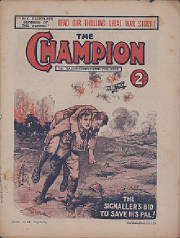
|
| 1929 - Champion cover |
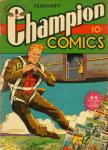
|
| 1939 - Champion comic cover |
NEWSPAPERS, BOOKS AND MAGAZINES
The
Champion was a British weekly boys' story paper
which ran from 1922 until 1955. It had a huge readereship across Australia, and I recall reading it as far
back as 1947! It consisted of stories about fictitious sporrting heroes - my favourites were Rockfist Rogan
(boxing) and Danny of the Dazzlers (soccer). I bought every issue until 1955!
Smith's Weekly was an Australian tabloid newspaper published
from 1919 to 1950, an independent weekly published in Sydney but read all over Australia, It was one of Australia’s
most patriotic newspaper-style magazines. I started reading this newspaper as early as 1946, until its demise. I particularly
liked the comic strips!
The Australian Boy. By the late 1940s and
early 1950s, comic books were proving immensely popular with Australian children, who could choose from both Australian-drawn
comics (such as Captain Atom or Bosun & Choclit),
or from a huge range of locally reprinted American comics (including Superman, Batman, or Felix the Cat, to name just a few.)
Yet it wasn’t
always like that. During the interwar decades, children’s ‘papers’, featuring a mixture of text stories,
activities, puzzles and comic strips, were popular with young readers. In Australia, the market was dominated by imported
British publications, but several Australian ‘children’s papers’ appeared throughout the 1920s and 30s,
including Pals, Cobbers, The Boys Weekly and The Comet.
The Australian wartime ban on
imported British publications, combined with the changing tastes of Aussie kids who’d been entranced by the colourful
American comic books first seen here in the late 1930s, saw the children’s paper lose ground to the increasingly popular
comic book format.
Yet even by the mid-to-late 1940s, some Australian publishers weren’t ready to give up on
the ‘old-fashioned’ children’s paper format just yet. Some of these short-lived titles included Aero, Young Australia and The Boomerang..
Perhaps
spurred on by the early success of Britain’s Eagle magazine (whose 1950 debut issue introduced the famous science-fiction
comic strip, Dan Dare), several Australian publishers tried to revive the ‘boys paper’ format for local audiences
throughout the 1950s.
Standard Newspapers Pty. Ltd., of Cheltenham, Victoria, scored an early success with a new magazine
titled Australian Boy.
Boy,
as the magazine was initially called, first appeared on 17 October 1952 (It changed its name to Australian Boy with its 20
February 1953 issue). Billed as a “thrill-packed comic magazine”, Australian Boy was published fortnightly as
a newsprint magazine.
No doubt keen to distinguish themselves from the ‘lurid’ comic books that were being
attacked in the press at the time, the publishers frequently promoted Australian Boy as “the comic newsagents are proud
to sell.”
The early, crudely coloured covers soon gave way to full-colour illustrations and photographs, which
usually depicted young boys like me taking part in a range of healthy outdoor activities, such as bushwalking, snorkelling,
swimming, rockpooling, flying model planes and fishing.
By the time Boy celebrated its first birthday in
1953, the Boy Club had been launched. Ultimately its membership would exceed
20,000, and readers were encouraged to wear their club badges proudly (as I did!). Boy also had its own weekly radio
program, Boy Time, on Melbourne 3AW and Central Victoria 3CV. Readers’
letters and jokes arrived in their hundreds, and a selection was printed in every issue. There was an active pen friend column.
Sadly the Boy ceased publication in 1955, due to rising production costs,
and greatly dimished demand.
I bought every issue of Boy, but I did not keep them.
Daily Newspapers. I was an avid reader of the Melbourne Argus morning
newspaper from as far back as 1946. One of the things I liked about this paper was its weekly supplements for kids.Sadly,
it ceased publication in 1954 - I kept a copy pf the final edition! In those years, there were three other daily
Melbourne papers - the Age (morning), the Sun (morning), and the Herald (afternoon)
The Hawthorn Library. This was
in Burwood Rd, next to the Hawthorn Town Hall. It was a two story cream brick building - the Children's Section
was upstairs, I first started going to the Library in 1947 - I used to ride my bike there. It opened in the evenings
at 7pm Mondays to Fridays. I soon outgrew the Childrens' Section and by 1949 I was borrowing books from the Adults'
Section.
My favourite author of childrens' was Enid Blyton, and I remember reading many
of her 21 novels about the adventures of the "Famous Five", written between 1942 and 1963, and the "Secret Seven",
15 novels written between 1949 and 1963.

|
| Australian Boy - cover |

|
| 1950 - the Boy Annual |

|
| Smith's Weekly |
|
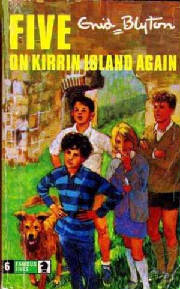
|
| Cover of an Enid Blyton novel |
|
